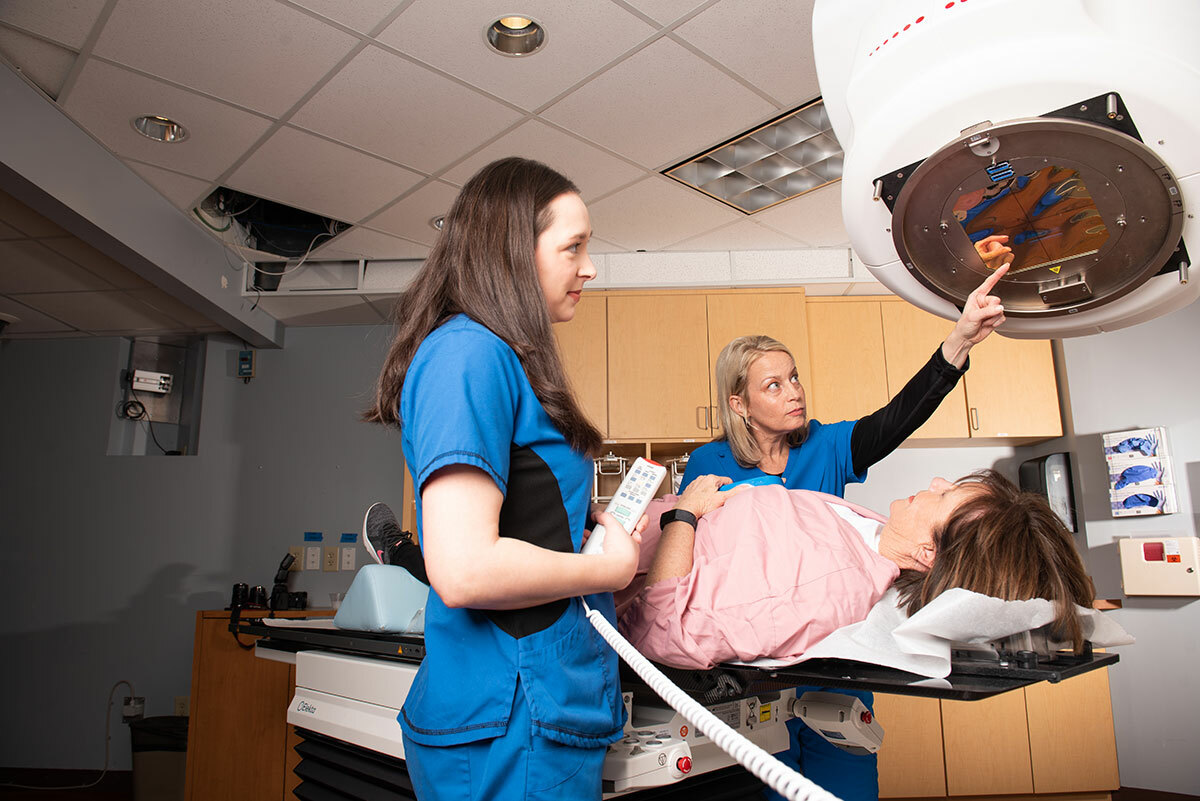
Radiation therapy is commonly used as part of the treatment plan for cervical cancer. Because the cervix is located near other organs such as the bladder, uterus, and colon, internal radiation therapy, also called intracavity brachytherapy, is often used, so the treatment is given more directly to the cervix. External beam radiation therapy is also an option to treat the area after surgery to ensure any remaining cancer cells are killed. Let’s take a look at how radiation therapy fits into the overall cervical cancer treatment plan.
What’s Included in a Cervical Cancer Treatment Plan?
Each patient receives a personalized cervical cancer treatment plan depending on the stage of cancer, the patient’s age and reproductive plans as well as their general health. This plan is developed by a gynecologic oncologist who works closely with other specialists such as the radiation oncologist.
Cervical Cancer Surgery
If the patient is younger and would like to be able to have children in the future, the treatment plan may be changed. The stage of the cancer also plays a big part in the decisions on which treatments should be included.
Most patients will have some type of surgery to remove the cancerous cells. If you’re going to have children in the future, a different type of surgery may be used so that the cervix remains intact. For those who are not planning to add to their families, a hysterectomy is often recommended to remove the cervix and uterus. In some cases, lymph nodes in the pelvic area will also be removed and then tested to see if there are any cancer cells present.
Radiation Therapy for Cervical Cancer
External beam radiation therapy can be used after surgery to kill remaining cancer cells or to treat recurrent cervical cancer or cancer that’s spread beyond the cervix.
Brachytherapy delivers a high dose of radioactive material directly into the cervix, reducing radiation exposure to surrounding tissues and organs.
The decision on whether one or both types of radiation therapy is best for the patient, along with when to give radiation therapy, is discussed between the gynecologic oncologist and the radiation oncologist.
Other Treatments for Cervical Cancer
Chemotherapy may be used if the cancer has entered the lymph system or has grown beyond the cervix. The gynecologic oncologist, who usually performs the surgery, also oversees the delivery of chemotherapy, targeted therapy and/or immunotherapy.
What Happens During Cervical Radiation Treatments?
The radiation oncologists at Radiotherapy Centers of Georgia begin treatment with a planning appointment. If you receive external beam radiation therapy (EBRT), you will go through a simulation where you’re placed precisely where you need to be during each treatment so that the radiation beams are sent to the exact same spot during every session.
EBRT is painless and only lasts a few minutes. Most of your treatment time is spent getting into position. At each outpatient session, you’ll lie down, and your pelvic area is treated with radiation from multiple directions.
External radiation treatments are usually given for four to six weeks, five days a week.
If you’re receiving brachytherapy, a small device is placed into the vagina with radioactive pellets in the tube. The length of time the tube remains in the vagina depends on whether you’re receiving low-dose brachytherapy or high-dose brachytherapy.
- The low-dose rate (LDR) method requires several days in a hospital while instruments hold the radioactive material in place.
- High-dose-rate (HDR) brachytherapy is given as an outpatient. Three to five treatments are spaced about a week apart. The radioactive material is inserted for up to an hour and then removed. HDR treatment avoids a hospital stay and remaining immobile for periods of time. HDR is as effective as LDR treatment.
Are External Radiation and Brachytherapy Used Together?
Brachytherapy can be used after a combination of chemotherapy and external radiation treatments.
External beam radiation therapy and brachytherapy are used together whenever the combination can provide a more effective treatment. Combining treatments can increase the dose of radiation to improve your chances of eliminating the cancer and entering remission. Combination treatments are usually given to patients who have advanced cervical cancer.
Are There Side Effects from Radiation Therapy?
Although some patients don’t have radiation side effects, many cervical cancer patients develop some or all of them. Side effects usually go away several weeks after treatment ends and can include:
- Fatigue
- Vaginal soreness, pain, or discharge
- Loss of pubic hair, primarily from external beam treatments
- Menstrual cycle changes if the patient receives treatment before menopause
- Stomach issues such as diarrhea, nausea, or vomiting
- Frequent urge to urinate, uncomfortable urination, or blood in the urine
- Skin redness, peeling, or flaking in the area that receives external beam radiation
- Low blood counts which can cause anemia from low red blood cells and increased infection risk from a low white blood cell count
- Low blood platelet counts can increase bleeding risks
There are a variety of factors that can impact how a patient responds to treatments. Patients who receive chemotherapy and radiation usually have lower blood counts and worse fatigue and nausea. Patients who smoke generally experience worse side effects. Smoking also reduces the effectiveness of the treatments.
Brachytherapy can cause some of the same side effects as EBRT, especially fatigue, nausea, diarrhea, low blood counts, and irritation of the bladder, vagina, and vulva.
Are There Long-term Side Effects?
Although less common, long-term side effects can occur months or years after EBRT and/or brachytherapy treatment has ended. They may include:
- Scar tissue on the vaginal lining, called vaginal stenosis, makes the vagina stiffer, narrower, or shorter, causing painful sex or pelvic examinations. A dilator can be used at home to maintain vaginal pliability.
- Vaginal dryness and damage to the vaginal lining can be helped with internal estrogen cream or gel.
- Chronic inflammation of the rectal area can cause bleeding or narrowing of the rectum.
- A fistula (an abnormal opening) may form between the rectum and vagina, allowing stool to exit the body via the vagina. Fistulas can also occur between the bladder and vagina. Fistulas may require surgery.
- Chronic bladder inflammation (cystitis).
- Weakened bones increase fracture risks, especially the hip.
- Leg swelling (lymphedema) can occur if pelvic lymph nodes receive radiation.
Most patients do not experience all of these long-term effects.
Atlanta Area Cervical Cancer Treatment
If you have received a cervical cancer diagnosis and radiation therapy will be a part of the treatment plan, be sure to evaluate the radiation treatment options. External beam radiation therapy will require quite a few trips to the cancer center and should be convenient for you.
Patients in the Atlanta area can receive radiation therapy close to home at any of our treatment centers with advanced technologies in Conyers, Covington, Decatur, and Snellville, Georgia. Request an appointment today to discuss your options with our radiation oncologists.




